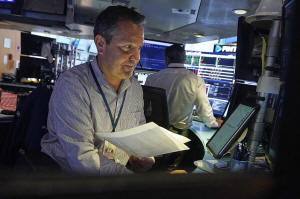Wall Street ticks higher after a rally wrapped around the world
[August 14, 2025] By
STAN CHOE
NEW YORK (AP) — U.S. stocks ticked higher on Wednesday after a rally
spurred by hopes for lower U.S. interest rates wrapped around the world.
The S&P 500 rose 0.3%, coming off its latest all-time high. The Dow
Jones Industrial Average climbed 463 points, or 1%, while the Nasdaq
composite added 0.1% to its own record set the day before.
Treasury yields eased in the bond market as expectations reached a
virtual consensus that the Federal Reserve will cut its main interest
rate for the first time this year at its next meeting in September.
Lower rates can boost investment prices and the economy by making it
cheaper for U.S. households and businesses to borrow to buy houses, cars
or equipment, though they risk worsening inflation.
Stock indexes in Asia jumped in their first trading after Tuesday’s
better-than-expected report on U.S. inflation triggered a jump in bets
that a cut to interest rates is coming. Hong Kong’s Hang Seng leaped
2.6%, Japan’s Nikkei 225 rallied 1.3% and South Korea’s Kospi climbed
1.1%.
Indexes also rose in Europe, though the moves were more modest after
they already had the chance to trade on the U.S. inflation data the
afternoon before. Germany’s DAX returned 0.7%, and France’s CAC 40 rose
0.7%.
On Wall Street, stocks of companies that could benefit most from lower
interest rates helped lead the way. PulteGroup climbed 5.4%, and Lennar
rose 5.2% as part of a broad rally for homebuilders and others in the
housing industry. Lower rates could make mortgages cheaper to get, which
could spur more buying.

The hopes for lower interest rates are helping to drown out criticism
that the U.S. stock market has broadly grown too expensive after its big
leap since hitting a low in April.
One way companies can make their stock prices look less expensive is to
deliver strong growth in profits, and Brinker International rose 1.6%
after becoming the latest to report stronger results for the latest
quarter than analysts expected. The company behind the Chili’s brand
said it saw more customers coming to its restaurants, and it’s also
making more profit off each $1 in sales.
“Chili’s is officially back, baby back!” CEO Kevin Hochman said.
HanesBrands climbed 3.7% after it agreed to sell itself to Gildan
Activewear for $2.2 billion in cash and Gildan stock. The deal would
combine North Carolinas’ HanesBrands with Canada’s Gildan, and Gildan’s
stock that trades in the United States rose 11.8%.
Bullish soared in its debut on the New York Stock Exchange and rose
83.8% in its first day of trading. The cryptocurrency exchange’s CEO is
Tom Farley, who used to be president of the NYSE Group.
[to top of second column] |

Trader Leon Montana works on the floor of the New York Stock
Exchange, Wednesday, Aug. 13, 2025. (AP Photo/Richard Drew)
 On the losing end of Wall Street
were grocery stores and delivery companies, which fell after Amazon
said it will offer fresh groceries to customers in more than 1,000
cities and towns through same-day delivery. Kroger fell 4.4%, and
DoorDash dropped 3.8%, while Amazon rose 1.4%.
Cava Group sank 16.6% after the Mediterranean restaurant chain
reported weaker revenue for the latest quarter than analysts
expected, though its profit topped forecasts. It also cut its 2025
forecast for an important underlying measure of restaurant sales.
CoreWeave lost 20.8% after the company, whose cloud platform helps
customers running artificial-intelligence workloads, reported a
larger loss for the latest quarter than analysts expected.
All told, the S&P 500 rose 20.82 points to 6,466.58. The Dow Jones
Industrial Average jumped 463.66 to 44,922.27, and the Nasdaq
composite added 31.24 to 21,713.14.
In the bond market, Treasury yields eased as expectations built for
coming cuts to interest rates by the Fed.
The yield on the 10-year Treasury fell to 4.23% from 4.29% late
Tuesday and from 4.50% in mid-July. That’s a notable move for the
bond market.
President Donald Trump has angrily been calling for cuts to help the
economy, often insulting the Fed’s chair personally while doing so.
But the Fed has been hesitant so far because of the possibility that
Trump’s tariffs could make inflation much worse. Lowering rates
would give inflation more fuel, potentially adding oxygen to a
growing fire. That’s why Fed officials have said they wanted to see
more data come in about inflation before moving.
On Thursday, a report will show how bad inflation was at the
wholesale level across the United States. Economists expect it to
show inflation accelerated a touch to 2.4% in July from 2.3% in
June.
___
AP Business Writers Matt Ott and Elaine Kurtenbach contributed.
All contents © copyright 2025 Associated Press. All rights reserved
 |